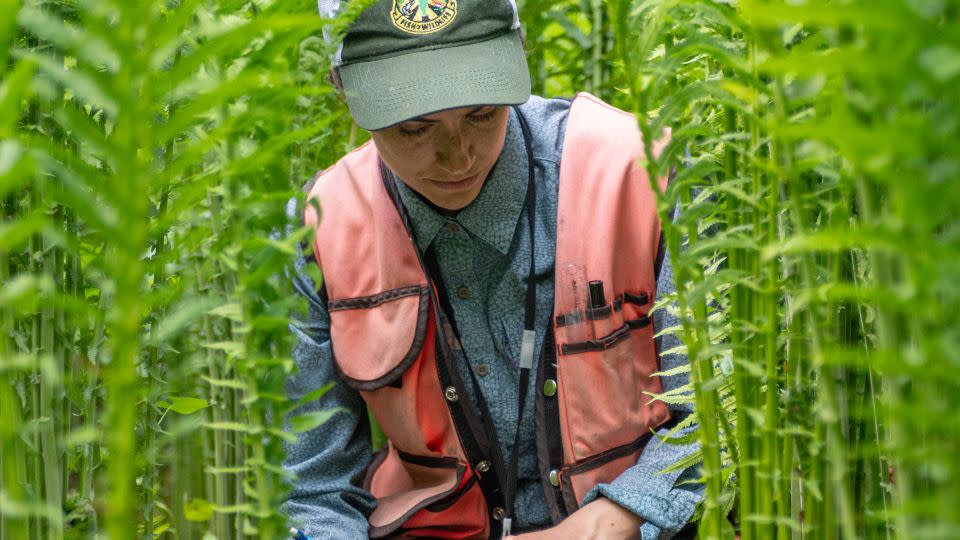Molly Parren was tracking a wood turtle in Vermont when she smelled something surprising, yet familiar. The amphibian scientist for the state’s wildlife agency traced the smell to a rare wild garlic and snapped a photo.
What she didn’t realize at the time was she had found not one but two rare plants — one of which hadn’t been seen in the state since 1916.
Parren sent the photo to her colleague Grace Glynn, Vermont’s state botanist.
“I saw this other plant in the foreground, this tiny, little plant that had a much different color.” Glynn told CNN. “I immediately knew that it was floerkea. False mermaid-weed.”
Glynn has been searching for this plant “a little bit obsessively,” she said. Its ephemeral nature meant that it could easily go unspotted. Its short blooming window begins in April. To say its white flowers are small is an understatement — they are the size of a pin head. Then by June, the plant is withering away.
There are also only three historic sites for floerkea in the state, according to Glynn. “I’ve just dreamt of finding it because this is such an inconspicuous little plant with a limited window visibility and I knew that it could be lurking in plain sight. I’ve never seen it in person, but I had looked at photos so many times,” she said.
When she saw what Parren photographed, Glynn “jumped up and screamed.”
False mermaid-weed needs open floodplain soil in order to germinate — but this means these kinds of plants are susceptible to invasive species including garlic mustard, reed canary grass and Japanese knotweed, among others, Glynn explained. Invasive species “choke out” floodplain habitats, making it hard for native plants to compete.
Most of the invasive species come from gardens, Glynn said. But they aren’t the only threat to native plants.
The increase in flooding in New England is very “concerning because it may be altering these habitats in ways that floerkea and other river-shore species are not adapted to,” Glynn said. Most river shore plants have evolved to benefit from winter and spring flooding — not flooding in the summer.
During the summer, plants will begin to reproduce and flower. Flooding can damage the plant during that critical process, forcing it to start over again. Glynn said this is “really stressful,” and while some plants may be able to quickly resprout and send up new flowers, “after multiple seasons of this happening, you can imagine that it may be too stressful on the plants and they could die or be outfitted by invasives.“

The challenge for plants is that they can’t run away from bad conditions, said Tim Johnson, the CEO of the Native Plant Trust, an organization that — true to its name — works to restore native plants, educate property owners and implement native species into landscape design.
“Plant species and communities have evolved over millions of years, and they have been able to adapt to or migrate away from unfavorable climate conditions,” Johnson told CNN. “The species we have today are the survivors. They’re the ones that have been able to navigate this process over time.”
Johnson explained certain species of plants have wider distribution than others and that Vermont is on the edge of the range of distribution for the false mermaid-weed, which is why the population size isn’t as large as it is in other states, making it more rare.
“Plant species and communities have evolved over millions of years, and they have been able to adapt to or migrate away from unfavorable climate conditions,” Johnson said. “The species we have today are the survivors. They’re the ones that have been able to navigate this process over time. The challenge, or one of the major challenges, with plants, is that they can’t run away.”
Native plants have evolved in balance with the rest of the ecosystem. Local pollinators and wildlife rely on native species, and are just as threatened by invasive, non-local plants as the natives themselves.
“Some native insects rely on very specific host plants or host species to complete their life cycles,” Glynn said. “And then the birds rely on (the insects), and so on, throughout the food chain.”
Glynn said much of work relies on enthusiasts, volunteers and other professional botanists sending her photos and videos of their observations. Every species “has a right to be given a chance to persist on the landscape, and that’s really why we do what we do,” Glynn said.
The false mermaid-weed discovery shows there is reason to hope the world can undo the harmful effects of climate change, said Johnson.
“We might think that we are beyond it because we have supercomputers in our pocket and we have jets that’ll carry you across and around the world, but everything about our lives actually is facilitated by plants,” Johnson said. “They are the primary producers in our world. We eat them. We use them for building materials. They produce the oxygen we breathe. We literally couldn’t live without them.”
Vermont Fish & Wildlife tracks hundreds of plant species across the state and publishes findings on its website. You can report a sighting of a rare species in Vermont by submitting this form.
For more CNN news and newsletters create an account at CNN.com
